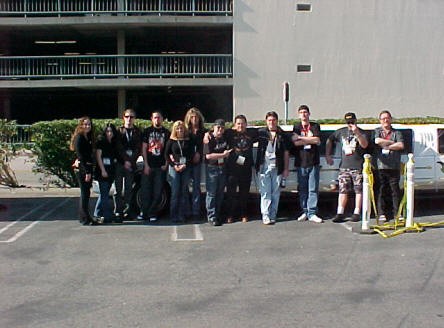Why Does Old Wood Sound Better?

FAQ
|
Q. Why is older wood better than new wood?
A. Wah, Dude it just sounds better. (typical
chain store guitar salesman)
Q. Yeah, I already know that but
WHY does it
sound
Better?
A. Dude! it's older and it got mellower, and the
resonance builds up in the wood for years, Believe me man, it really sounds
better!
|
Does the above BS sound all too
familiar ??
|
I will now attempt the rocket scientist, propeller head,
scientific explanation. Please remember that I used the word attempt because
believe me, I'm no Rocket Scientist.
Hundreds of years ago the density levels of our forest lands
were much more dense than they are today. Trees grew very closely together.
Trees grew at a much slower rate because they were all competing with each other
for sunlight, water and basic organic nutrients from the forest floor.
If you look at an older piece of wood you will immediately
notice more growth rings per inch and the tighter wood mass definitely plays a
part in acoustic resonance. Trees Simply Grew
Much Slower Then Than Now !
Today loggers replant trees at a wider space because they
know that they can reduce the growth rate from 200 years to 75 years and get the
same yield. Also logging the trees becomes much easier when the trees are
planted in such a way that would prevent entanglement and accidents during the
cutting down process.
When the Great Lakes logging industry started almost 200
years ago, virgin wood logs were floated to the mills on the lakes. Some of
these old growth logs sank and remained submerged in an icy cold, low oxygen
environment. During their long stay underwater the anaerobic bacteria stripped
away the sap and other impurities in the cells and fiber of the wood. This
process left literally billions of microscopic and sub microscopic chambers in
the wood.
A strange paradox occurs, The microscopic tone chambers make
the wood unusually light for old dense grain which usually determines the guitar
will have to be very heavy.
Because 18th century loggers stamped and dated their logs
this wood can actually be dated to the year it was cut. The potential exists for
some of this wood to actually be 500 years old.
Imagine light weight old wood, A guitar builders dream come
true. I intend to use the Timeless Timber as backs and necks for many of the
guitars I will be producing in the future.
Ed Roman
June 1998
I Stand Corrected On The Timeless Timber
I have now built some Timeless Timber guitars and I am no
longer impressed!!!
In fact they sounded dead and the resonation factor has been below average
So I Was Wrong, I Think Maybe The Wood Was Submerged Too Long
Old Wood
Ed Roman 2001
|
|
Reader Written Very Interesting
Information
Just read your
section on “old wood” on your website, and wanted to offer my two
cents. I’ve always held the assumption that old wood must be better
for guitar building, because it’s denser than modern wood. But I’ve
never built a guitar don’t have any expertise there, so I can’t
speak to the quality of “old wood” for guitar construction. But I’m
a professional wildlife biologist, and have studied forested
wildlife habitat and its development extensively. So let me give
you a new perspective on “old wood”. Here’s how “old wood” gets
that way, and the reasons for its greater density than modern wood.
The physical
structure of forests worldwide has changed over the centuries. To
greatly oversimplify a complex situation that varies from one
ecosystem to another, forests used to consist of much larger, older
trees more widely spaced, not denser, than they are today. Trees of
many species grow rapidly in early life and slow down greatly as
they get older. Rapid growth leads to widely spaced growth rings,
and thus less dense, less resonant wood. A maple, for instance,
might grow quite rapidly for the first 50 years or so, and grow to a
respectable size laying down relatively thick layers of low-density
wood. But it can live another couple of hundred years beyond that,
growing more slowly, and depositing much thinner, more
closely-spaced layers of dense, resonant wood.
The cellular structure of slow-growing, dense wood is tighter,
with higher content of lignin and other structural proteins, and
that probably lends it more resonance. So “old wood” comes from old
trees.
|
So why don’t modern
trees produce the same kind of wood? Two reasons. First and
foremost, they are logged before they get old enough for growth
rates to slow. Since commercial timber harvesting came to North
America with Europeans, we’ve cut the vast majority of the really
old trees. Now that the old trees are cut and timber companies are
trying to harvest timber like a crop, time is money. When the
growth rate of a stand of trees slows down, the rate at which an
acre of land produces more board feet of lumber slows down. It is
more profitable for timber companies to keep the forest in the
fast-growing phase, so they cut it and replant it. Most
commercially logged forests (including our National Forests) are cut
on roughly a 60-year rotation. For similar reasons, less
well-regulated forests, say, in the tropics (mahogany, etc.) are
nowadays cut before they can get old and produce dense, high-quality
wood. The easily accessible 500-year-old, 10-12 foot-thick mahogany
trees were cut years ago. Now all that remains are much younger
trees that are cut as soon as they get to a respectable size.
The other reason
that forests were less densely populated, with larger trees (at
least in temperate coniferous forests) is fire suppression. Before
people started putting out every forest fire as soon as they could,
forest fires were frequent, but low-intensity.
Frequent fires burned up the readily available fuel (brush, dead
limbs, small trees) in the forest under-story. Very young trees
were routinely killed by these frequent, low-intensity fires, so
relatively few trees grew to a size where they had sufficiently
thick bark, and lower branches sufficiently high off the forest
floor, to avoid being killed by fire. So we get a forest structure
consisting of big, old trees spaced widely apart. Every five years
or so, a fire comes through, burns what little fuel has accumulated,
and doesn’t burn hot enough o kill the mature trees. In contrast,
when every fire that might go through a forest is put out, young
trees that would otherwise be killed by fire are allowed to grow,
resulting in a denser forest. Also, fuel loads (brush, dead limbs,
etc.) are allowed to accumulate, so that when a fire does manage to
burn through the forest, it burns much hotter than fires used to.
Instead of a tame little fire creeping through the dry grass at the
base of huge majestic trees with their vulnerable foliage high above
the fire, you have fire burning through dead brush and limbs,
climbing up into the canopy of the forest, killing the trees, and
once again preventing the development of really old, dense wood.
So where can we get
top-quality old wood today? Start sawing up antique furniture!
John Martin
San Diego,
California
|
|

Custom Made Ed Roman 7 String Guitar

2002

2004
|